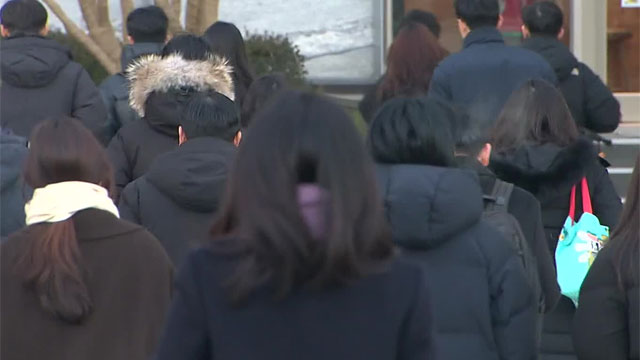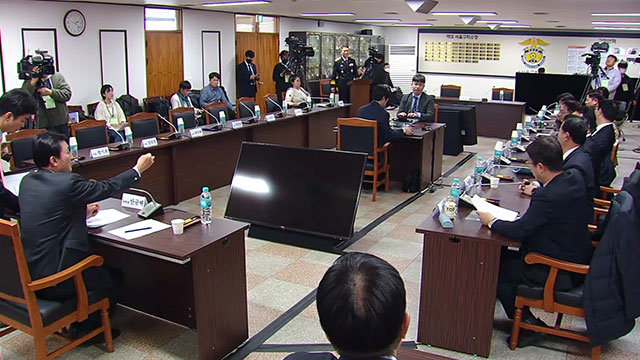[News Today] KOREAN RICE HARVEST IN GUINEA
입력 2024.12.26 (17:15)
수정 2024.12.26 (17:17)
읽어주기 기능은 크롬기반의
브라우저에서만 사용하실 수 있습니다.
[LEAD]
The 50-won Korean coin shows rice panicles, known as South Korea's unification rice. It helped Korea beat famine, and is now in Guinea, Africa. Starting with just 10 kilograms of seeds, the project grew to a 2,000-ton harvest in two years.
[REPORT]
A village in the west African nation of Guinea.
Women are in the middle of reaping rice while singing a joyous song.
This site marks the first harvest of a South Korean rice variety known as the unification rice.
Domestic rice in Guinea harvests about one ton per hectare but with the Korean breed, four to five tons of rice can be reaped.
Guinean farmer/
We started cultivating unification rice from this year. We have so much harvest. I'm so happy.
At another village, paddies of unification rice measure some 25 hectares.
The harvest is large enough for residents to consume themselves and sell the leftovers.
Guinean farmer/
Unification rice has larger output than Guinean rice and it also sells at a higher price.
Guinea has heavy rainfall and temperatures remain at around 30 degrees Celsius year-round. It's the perfect climate to grow unification rice.
An Da-young/ KBS correspondent
With the Korean rice, double cropping is possible here and even triple cropping elsewhere. This means a larger harvest is possible as much as ten fold the amount reaped with indigenous rice.
Just like Korea in the past, Guinea faces periodic famine every summer with 35% of its population grappling with a food crisis.
The UN World Food Programme launched a famine easing project in the country two years ago starting with ten kilograms of Korean unification rice.
The number of villages taking part in the project grew from seven to 150 while rice production surged from 75 tons to over 25-hundred tons.
Lim Hyoung-joon / Country director, WFP Guinea
Up until 1-2 years ago, people suffered malnutrition surviving on one meal a day but many now say they are no longer starving.
The World Food Programme plans to expand the unification rice project to all across Guinea.
The 50-won Korean coin shows rice panicles, known as South Korea's unification rice. It helped Korea beat famine, and is now in Guinea, Africa. Starting with just 10 kilograms of seeds, the project grew to a 2,000-ton harvest in two years.
[REPORT]
A village in the west African nation of Guinea.
Women are in the middle of reaping rice while singing a joyous song.
This site marks the first harvest of a South Korean rice variety known as the unification rice.
Domestic rice in Guinea harvests about one ton per hectare but with the Korean breed, four to five tons of rice can be reaped.
Guinean farmer/
We started cultivating unification rice from this year. We have so much harvest. I'm so happy.
At another village, paddies of unification rice measure some 25 hectares.
The harvest is large enough for residents to consume themselves and sell the leftovers.
Guinean farmer/
Unification rice has larger output than Guinean rice and it also sells at a higher price.
Guinea has heavy rainfall and temperatures remain at around 30 degrees Celsius year-round. It's the perfect climate to grow unification rice.
An Da-young/ KBS correspondent
With the Korean rice, double cropping is possible here and even triple cropping elsewhere. This means a larger harvest is possible as much as ten fold the amount reaped with indigenous rice.
Just like Korea in the past, Guinea faces periodic famine every summer with 35% of its population grappling with a food crisis.
The UN World Food Programme launched a famine easing project in the country two years ago starting with ten kilograms of Korean unification rice.
The number of villages taking part in the project grew from seven to 150 while rice production surged from 75 tons to over 25-hundred tons.
Lim Hyoung-joon / Country director, WFP Guinea
Up until 1-2 years ago, people suffered malnutrition surviving on one meal a day but many now say they are no longer starving.
The World Food Programme plans to expand the unification rice project to all across Guinea.
■ 제보하기
▷ 카카오톡 : 'KBS제보' 검색, 채널 추가
▷ 전화 : 02-781-1234, 4444
▷ 이메일 : kbs1234@kbs.co.kr
▷ 유튜브, 네이버, 카카오에서도 KBS뉴스를 구독해주세요!
- [News Today] KOREAN RICE HARVEST IN GUINEA
-
- 입력 2024-12-26 17:15:50
- 수정2024-12-26 17:17:05
[LEAD]
The 50-won Korean coin shows rice panicles, known as South Korea's unification rice. It helped Korea beat famine, and is now in Guinea, Africa. Starting with just 10 kilograms of seeds, the project grew to a 2,000-ton harvest in two years.
[REPORT]
A village in the west African nation of Guinea.
Women are in the middle of reaping rice while singing a joyous song.
This site marks the first harvest of a South Korean rice variety known as the unification rice.
Domestic rice in Guinea harvests about one ton per hectare but with the Korean breed, four to five tons of rice can be reaped.
Guinean farmer/
We started cultivating unification rice from this year. We have so much harvest. I'm so happy.
At another village, paddies of unification rice measure some 25 hectares.
The harvest is large enough for residents to consume themselves and sell the leftovers.
Guinean farmer/
Unification rice has larger output than Guinean rice and it also sells at a higher price.
Guinea has heavy rainfall and temperatures remain at around 30 degrees Celsius year-round. It's the perfect climate to grow unification rice.
An Da-young/ KBS correspondent
With the Korean rice, double cropping is possible here and even triple cropping elsewhere. This means a larger harvest is possible as much as ten fold the amount reaped with indigenous rice.
Just like Korea in the past, Guinea faces periodic famine every summer with 35% of its population grappling with a food crisis.
The UN World Food Programme launched a famine easing project in the country two years ago starting with ten kilograms of Korean unification rice.
The number of villages taking part in the project grew from seven to 150 while rice production surged from 75 tons to over 25-hundred tons.
Lim Hyoung-joon / Country director, WFP Guinea
Up until 1-2 years ago, people suffered malnutrition surviving on one meal a day but many now say they are no longer starving.
The World Food Programme plans to expand the unification rice project to all across Guinea.
The 50-won Korean coin shows rice panicles, known as South Korea's unification rice. It helped Korea beat famine, and is now in Guinea, Africa. Starting with just 10 kilograms of seeds, the project grew to a 2,000-ton harvest in two years.
[REPORT]
A village in the west African nation of Guinea.
Women are in the middle of reaping rice while singing a joyous song.
This site marks the first harvest of a South Korean rice variety known as the unification rice.
Domestic rice in Guinea harvests about one ton per hectare but with the Korean breed, four to five tons of rice can be reaped.
Guinean farmer/
We started cultivating unification rice from this year. We have so much harvest. I'm so happy.
At another village, paddies of unification rice measure some 25 hectares.
The harvest is large enough for residents to consume themselves and sell the leftovers.
Guinean farmer/
Unification rice has larger output than Guinean rice and it also sells at a higher price.
Guinea has heavy rainfall and temperatures remain at around 30 degrees Celsius year-round. It's the perfect climate to grow unification rice.
An Da-young/ KBS correspondent
With the Korean rice, double cropping is possible here and even triple cropping elsewhere. This means a larger harvest is possible as much as ten fold the amount reaped with indigenous rice.
Just like Korea in the past, Guinea faces periodic famine every summer with 35% of its population grappling with a food crisis.
The UN World Food Programme launched a famine easing project in the country two years ago starting with ten kilograms of Korean unification rice.
The number of villages taking part in the project grew from seven to 150 while rice production surged from 75 tons to over 25-hundred tons.
Lim Hyoung-joon / Country director, WFP Guinea
Up until 1-2 years ago, people suffered malnutrition surviving on one meal a day but many now say they are no longer starving.
The World Food Programme plans to expand the unification rice project to all across Guinea.
이 기사가 좋으셨다면
-
좋아요
0
-
응원해요
0
-
후속 원해요
0










![[단독] “계엄 후 사기 저하” 호소하는데…장교들 <br>사생활 정보, 군 업무망에](/data/fckeditor/new/image/2025/02/05/314651738747996159.jpg)
![[단독] 의협회장 “의료공백 <br>환자 피해는 정부 미봉책 때문”](/data/fckeditor/new/image/2025/02/05/302271738741368940.jpg)



이 기사에 대한 의견을 남겨주세요.